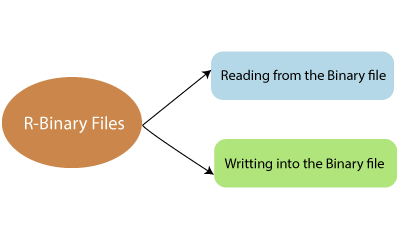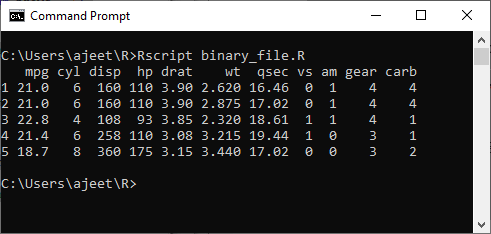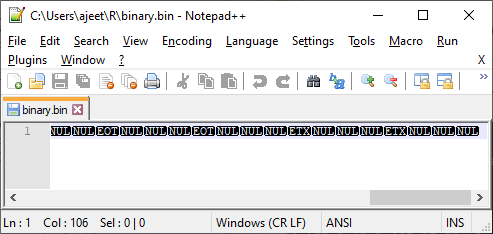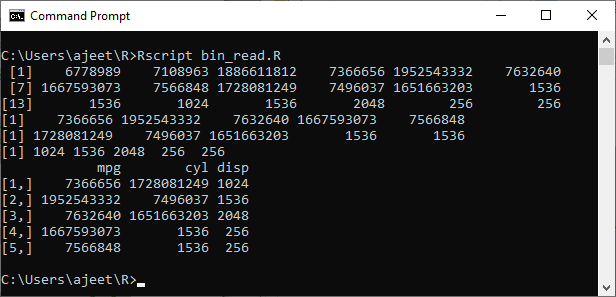📌 相关文章
- R-二进制文件
- R二进制文件(1)
- 文件到二进制 php (1)
- 文件到二进制 php 代码示例
- c# 到二进制 - C# (1)
- 十二进制数
- 十二进制数(1)
- 二进制求幂 - C++ (1)
- N位二进制数
- c# 读取二进制文件 - C# (1)
- 二进制代码 (1)
- 二进制代码(1)
- 二进制代码
- 在 R 编程中使用二进制文件(1)
- 在 R 编程中使用二进制文件
- 读取二进制文件 python (1)
- c# 读取二进制文件 - C# 代码示例
- c# 到二进制 - C# 代码示例
- 二进制求幂 - C++ 代码示例
- 在 python 中编写二进制文件(1)
- 读取二进制文件 python 代码示例
- 读取二进制文件 - Python 代码示例
- 如何制作假二进制文件 - Javascript (1)
- grep 二进制文件 (1)
- 二进制文件执行 - 任何代码示例
- 在 python 代码示例中编写二进制文件
- 如何制作假二进制文件 - Javascript 代码示例
- 二进制数(二进制中无连续的1)– O(1)方法(1)
- 二进制数(二进制中无连续的1)– O(1)方法
📜 R二进制文件
📅 最后修改于: 2021-01-08 09:51:37 🧑 作者: Mango
R二进制文件
二进制文件是仅包含以位和字节(0和1)形式存在的信息的文件。它们不是人类可读的,因为字节转换为包含许多其他不可打印字符的字符和符号。如果我们使用任何文本编辑器读取二进制文件,它将显示ð和Ø等字符。
该代码相对来说很容易将二进制数据读取为R。要读取二进制数据,我们必须知道如何将一条信息解析为二进制。
二进制文件必须由特定程序读取才能有用。例如,Microsoft Word程序的二进制文件只能由Word程序以人类可读的形式读取。它表明,除了人类可读的文本外,还有很多信息,例如字符格式和页码等,它们也与字母数字字符存储。最后,二进制文件是一个连续的字节序列。我们在文本文件中看到的换行符是将第一行连接到下一行的字符。
有时,其他程序生成的数据需要由R作为二进制文件进行处理。同样,R需要创建可以与其他程序共享的二进制文件。有两个函数writeBin()和readBin()用于在R中创建和读取二进制文件。

编写二进制文件
像CSV和Excel文件一样,我们也可以写入二进制文件。 R提供了writeBin()函数,用于将数据写入二进制文件。 writeBin()函数具有以下语法:
writeBin(object,con)
这里,
- “ con”是用于写入二进制文件的连接对象。
- “对象”是我们在其中写入数据的二进制文件。
让我们看一个示例,以了解如何使用此函数以二进制格式将数据写入文件。在以下示例中,我们将使用R内置数据“ mtcars”。我们将根据它创建一个CSV文件,并将其转换为二进制文件。
例
# Reading the "mtcars" data frame as a csv file and will store only the columns "cyl", "am" and "gear".
write.table(mtcars, file = "mtcars.csv",row.names = FALSE, na = "",
col.names = TRUE, sep = ",")
# Storing 5 records from the csv file as a new data frame.
new.mtcars <- read.table("mtcars.csv",sep = ",",header = TRUE,nrows = 5)
new.mtcars
# Creating a connection object to write the binary file using mode "wb".
write.filename = file("/Users/ajeet/R/binary.bin", "wb")
# Writing the column names of the data frame to the connection object.
writeBin(colnames(new.mtcars), write.filename)
# Writing the records in each of the column to the file.
writeBin(c(new.mtcars$cyl,new.mtcars$am,new.mtcars$gear), write.filename)
# Closing the file for writing so that other programs can read it.
close(write.filename)
输出量


读取二进制文件
我们还可以读取之前创建的二进制文件。为此,R提供了readBin()函数,用于从二进制文件读取数据。
readbin()函数具有以下语法:
readBin(con,what,n)
这里,
- “ con”是用于读取二进制文件的连接对象。
- “ what”是表示要读取的字节的模式,例如字符,整数等。
- ?n'是我们要从二进制文件读取的字节数。
让我们看一个例子,其中我们从binary.bin文件读取二进制数据。
例
# Creating a connection object to read the file in binary mode using "rb".
read.filename <- file("/Users/ajeet/R/binary.bin", "rb")
# Reading the column names. n = 3 as we have 3 columns.
column.names <- readBin(read.filename, character(), n = 3)
# Reading the column values. n = 18 as we have 3 column names and 15 values.
read.filename <- file("/Users/ajeet/R/binary.bin", "rb")
bin_data <- readBin(read.filename, integer(), n = 18)
# Printing the data.
print(bin_data)
# Reading the values from 4th byte to 8th byte, which represents "cyl."
cyl_data = bin_data[4:8]
print(cyl_data)
# Reading the values form 9th byte to 13th byte which represents "am".
am_data = bin_data[9:13]
print(am_data)
# Reading the values form 9th byte to 13th byte which represents "gear".
gear_data = bin_data[14:18]
print(gear_data)
# Combining all the read values to a dat frame.
final_data = cbind(cyl_data, am_data, gear_data)
colnames(final_data) = column.names
print(final_data)
输出量
